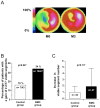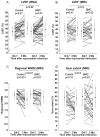Intracoronary autologous mononucleated bone marrow cell infusion for acute myocardial infarction: results of the randomized multicenter BONAMI trial
- PMID: 21127322
- PMCID: PMC3386167
- DOI: 10.1093/eurheartj/ehq455
Intracoronary autologous mononucleated bone marrow cell infusion for acute myocardial infarction: results of the randomized multicenter BONAMI trial
Abstract
Aims: Intracoronary administration of autologous bone marrow cells (BMCs) leads to a modest improvement in cardiac function, but the effect on myocardial viability is unknown. The aim of this randomized multicentre study was to evaluate the effect of BMC therapy on myocardial viability in patients with decreased left ventricular ejection fraction (LVEF) after acute myocardial infarction (AMI) and to identify predictive factors for improvement of myocardial viability.
Methods and results: One hundred and one patients with AMI and successful reperfusion, LVEF ≤45%, and decreased myocardial viability (resting Tl201-SPECT) were randomized to either a control group (n = 49) or a BMC group (n = 52). Primary endpoint was improvement of myocardial viability 3 months after AMI. Baseline mean LVEF measured by radionuclide angiography was 36.3 ± 6.9%. Bone marrow cell infusion was performed 9.3 ± 1.7 days after AMI. Myocardial viability improved in 16/47 (34%) patients in the BMC group compared with 7/43 (16%) in the control group (P = 0.06). The number of non-viable segments becoming viable was 0.8 ± 1.1 in the control group and 1.2 ± 1.5 in the BMC group (P = 0.13). Multivariate analysis including major post-AMI prognostic factors showed a significant improvement of myocardial viability in BMC vs. control group (P = 0.03). Moreover, a significant adverse role for active smoking (P = 0.04) and a positive trend for microvascular obstruction (P = 0.07) were observed.
Conclusion: Intracoronary autologous BMC administration to patients with decreased LVEF after AMI was associated with improvement of myocardial viability in multivariate-but not in univariate-analysis. A large multicentre international trial is warranted to further document the efficacy of cardiac cell therapy and better define a group of patients that will benefit from this therapy.
Clinical trial registration information: URL: http://www.clinicaltrials.gov. Unique identifier NCT00200707.
Conflict of interest statement
The authors declare no conflict of interest.
Figures




Similar articles
-
Intracoronary infusion of mononuclear cells from bone marrow or peripheral blood compared with standard therapy in patients after acute myocardial infarction treated by primary percutaneous coronary intervention: results of the randomized controlled HEBE trial.Eur Heart J. 2011 Jul;32(14):1736-47. doi: 10.1093/eurheartj/ehq449. Epub 2010 Dec 10. Eur Heart J. 2011. PMID: 21148540 Clinical Trial.
-
Effect of intracoronary delivery of autologous bone marrow mononuclear cells 2 to 3 weeks following acute myocardial infarction on left ventricular function: the LateTIME randomized trial.JAMA. 2011 Nov 16;306(19):2110-9. doi: 10.1001/jama.2011.1670. Epub 2011 Nov 14. JAMA. 2011. PMID: 22084195 Free PMC article. Clinical Trial.
-
A randomized double-blind control study of early intra-coronary autologous bone marrow cell infusion in acute myocardial infarction: the REGENERATE-AMI clinical trial†.Eur Heart J. 2016 Jan 14;37(3):256-63. doi: 10.1093/eurheartj/ehv493. Epub 2015 Sep 23. Eur Heart J. 2016. PMID: 26405233 Free PMC article. Clinical Trial.
-
Impact of intracoronary bone marrow cell therapy on left ventricular function in the setting of ST-segment elevation myocardial infarction: a collaborative meta-analysis.Eur Heart J. 2014 Apr;35(15):989-98. doi: 10.1093/eurheartj/eht372. Epub 2013 Sep 11. Eur Heart J. 2014. PMID: 24026778 Free PMC article. Review.
-
Effects of intracoronary autologous bone marrow cells on left ventricular function in acute myocardial infarction: a systematic review and meta-analysis for randomized controlled trials.Coron Artery Dis. 2008 Aug;19(5):327-35. doi: 10.1097/MCA.0b013e328300dbd3. Coron Artery Dis. 2008. PMID: 18607170 Review.
Cited by
-
A long road for stem cells to cure sick hearts: update on recent clinical trials.Korean Circ J. 2012 Feb;42(2):71-9. doi: 10.4070/kcj.2012.42.2.71. Epub 2012 Feb 27. Korean Circ J. 2012. PMID: 22396692 Free PMC article.
-
Adult Bone Marrow Cell Therapy for Ischemic Heart Disease: Evidence and Insights From Randomized Controlled Trials.Circ Res. 2015 Aug 28;117(6):558-75. doi: 10.1161/CIRCRESAHA.114.304792. Epub 2015 Jul 9. Circ Res. 2015. PMID: 26160853 Free PMC article. Review.
-
Cell-Based Therapy for Myocardial Dysfunction After Fontan Operation in Hypoplastic Left Heart Syndrome.Mayo Clin Proc Innov Qual Outcomes. 2017 Aug 2;1(2):185-191. doi: 10.1016/j.mayocpiqo.2017.07.002. eCollection 2017 Sep. Mayo Clin Proc Innov Qual Outcomes. 2017. PMID: 30225415 Free PMC article.
-
Key Success Factors for Regenerative Medicine in Acquired Heart Diseases.Stem Cell Rev Rep. 2020 Jun;16(3):441-458. doi: 10.1007/s12015-020-09961-0. Stem Cell Rev Rep. 2020. PMID: 32297205 Free PMC article. Review.
-
Laser-supported CD133+ cell therapy in patients with ischemic cardiomyopathy: initial results from a prospective phase I multicenter trial.PLoS One. 2014 Jul 7;9(7):e101449. doi: 10.1371/journal.pone.0101449. eCollection 2014. PLoS One. 2014. PMID: 25000346 Free PMC article. Clinical Trial.
References
-
- Strauer BE, Brehm M, Zeus T, Kostering M, Hernandez A, Sorg RV, Kogler G, Wernet P. Repair of infarcted myocardium by autologous intracoronary mononuclear bone marrow cell transplantation in humans. Circulation. 2002;106:1913–1918. - PubMed
-
- Schachinger V, Erbs S, Elsasser A, Haberbosch W, Hambrecht R, Holschermann H, Yu J, Corti R, Mathey DG, Hamm CW, Suselbeck T, Assmus B, Tonn T, Dimmeler S, Zeiher AM. Intracoronary bone marrow-derived progenitor cells in acute myocardial infarction. N Engl J Med. 2006;355:1210–1221. - PubMed
-
- Wollert KC, Meyer GP, Lotz J, Ringes-Lichtenberg S, Lippolt P, Breidenbach C, Fichtner S, Korte T, Hornig B, Messinger D, Arseniev L, Hertenstein B, Ganser A, Drexler H. Intracoronary autologous bone-marrow cell transfer after myocardial infarction: the BOOST randomised controlled clinical trial. Lancet. 2004;364:141–148. - PubMed
-
- Meyer GP, Wollert KC, Lotz J, Steffens J, Lippolt P, Fichtner S, Hecker H, Schaefer A, Arseniev L, Hertenstein B, Ganser A, Drexler H. Intracoronary bone marrow cell transfer after myocardial infarction: eighteen months’ follow-up data from the randomized, controlled BOOST (BOne marrOw transfer to enhance ST-elevation infarct regeneration) trial. Circulation. 2006;113:1287–1294. - PubMed
-
- Janssens S, Dubois C, Bogaert J, Theunissen K, Deroose C, Desmet W, Kalantzi M, Herbots L, Sinnaeve P, Dens J, Maertens J, Rademakers F, Dymarkowski S, Gheysens O, Van Cleemput J, Bormans G, Nuyts J, Belmans A, Mortelmans L, Boogaerts M, Van de Werf F. Autologous bone marrow-derived stem-cell transfer in patients with ST-segment elevation myocardial infarction: double-blind, randomised controlled trial. Lancet. 2006;367:113–121. - PubMed
Publication types
MeSH terms
Associated data
LinkOut - more resources
Full Text Sources
Other Literature Sources
Medical

